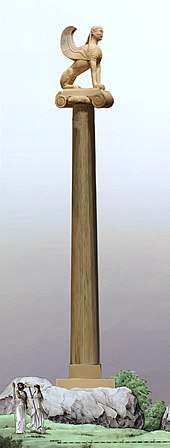Temple of Apollo (Delphi)
| Temple of Apollo | |
|---|---|
 | |
| Basic information | |
| Location | Delphi |
| Geographic coordinates | Coordinates: 38°28′56″N 22°30′04″E / 38.48222°N 22.50111°E |
| Deity | Apollo |
| Region | Ancient Greece |
| Architect(s) |
|
The ruins of the Temple of Apollo visible today date from the 4th century BC, and are of a peripteral Doric building. It was erected by Spintharus, Xenodoros, and Agathon on the remains of an earlier temple, dated to the 6th century BC which itself was erected on the site of a 7th-century BC construction attributed to the architects Trophonios and Agamedes.[1]
The 6th-century BC temple was named the "Temple of Alcmonidae" in tribute to the Athenian family who funded its reconstruction following a fire, which had destroyed the original structure. The new building was a Doric hexastyle temple of 6 by 15 columns. This temple was destroyed in 375 BC by an earthquake. The pediment sculptures are a tribute to Praxias and Androsthenes of Athens. Of a similar proportion to the second temple it retained the 6 by 15 column pattern around the stylobate.[1] Inside was the adyton, the centre of the Delphic oracle and seat of Pythia. The temple had the statement "Know thyself", one of the Delphic maxims, carved into it (and some modern Greek writers say the rest were carved into it), and the maxims were attributed to Apollo and given through the oracle and/or the Seven Sages of Greece ("know thyself" perhaps also being attributed to other famous philosophers).

The temple survived until AD 390, when the Roman emperor Theodosius I silenced the oracle by destroying the temple and most of the statues and works of art in the name of Christianity.[2] The site was completely destroyed by zealous Christians in an attempt to remove all traces of Paganism.[2] The ruins of this temple decay at a faster rate than some of the other ruins on the Southern slopes of the Parnassos mountain. This is mostly due to the use of limestone, a softer material, along with porous stone.[3]
The first temple of Apollo was, according to the myth, made of daphne (laurel the sacred symbol of Apollo), the second temple of Apollo was made of bees wax and feathers (the remains of two structures dating from the 8th century BC could be associated with the first two temples), the third temple of Apollo was made out of bronze, the fourth temple of Apollo was constructed around the end of the 7th century BC and, according to Pausanias, ruined by fire in 548 BC, the fifth temple of Apollo (Alcmaeonid Temple) was constructed between 525-505 BC and ruined by fire or earthquake in 373 BC, the sixth temple of Apollo was finished in 320 BC and is the one visible today.[4]
References
- 1 2 Sakoulas, Thomas. "Temple of Apollo at Delphi". Ancient-Greece.org. Retrieved 28 November 2016.
- 1 2 Trudy Ring, Robert M. Salkin, Sharon La Bod, International Dictionary of Historic Places: Southern Europe; Page 185;
- ↑ "Temple of Apollo at Delphi". Ancient-Greece.org. Ancient-Greece.org. Retrieved 2 October 2017.
- ↑ Gruben G., Griechische Tempel und Heiligtümer, München, 2001